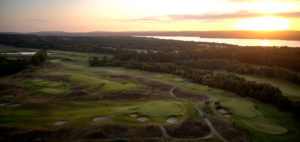Recovery Amongst Restriction For The Golf Industry?
 It has been widely highlighted that golf is inherently suited to a society practicing social distancing and a return to the fairways could be sooner rather than later, with recent reports suggesting that golf could be amongst the few sporting activities that reopen ahead of others.
It has been widely highlighted that golf is inherently suited to a society practicing social distancing and a return to the fairways could be sooner rather than later, with recent reports suggesting that golf could be amongst the few sporting activities that reopen ahead of others.
As sports go, golf is only ever really played by a maximum of four people and with several hundred yards between one group and the next, there is minimal interaction between players. And where touching points do exist, we have already seen effective solutions that have allowed the game to continue under such measures; defined routes bypassing (closed) clubhouses (from car park to 1st tee and 18th green to car park), single player tee times, removal of rakes and upturned/lipped pin cups.
Given the inevitability that distancing measures will continue even when restrictions ease, golf will find itself uniquely positioned as one of few who are able to resume play and find some kind of normality amongst it all.
There is no question that this provides real opportunities for the game and prompts discussions on how golf and its courses can consider their options to reinvigorate the game and offer solutions for a sustainable future.
Primary among these, in my view, could be to introduce shorter alternatives of the game. Whether that may be through introducing course loops of 3, 6 or 9-holes, for example – or perhaps (temporary) Par 3 layouts that use existing course elements. Shorter courses will require less maintenance, resources and associated costs and in light of the ‘essential maintenance’ limitations set in place by the R&A and local authorities, shorter alternatives, such as these, could offer an intermediate solution for commercial operations, access to golf and of course health and well-being benefits.
It baffles me that there aren’t more shorter facilities designed purely for fun and I have been a big believer and advocate of shorter forms of the game for a long time. But now such alternatives could really be embraced, their benefits exposed and perhaps a more sustainable future for golf established.
Following on from this, and taking a broader perspective, the game will be swamped by golfers who have been denied their fix over the past couple of weeks. But the game will also likely find itself in the cross hairs of non-golfers’ attention too, thrust into the limelight as a genuine option for sports amongst a limited field of choices. Fuelled by this newfound attention, it puts golf clubs and the wider game in a fantastic position for growth.
The successes of the likes of TopGolf, city-based golf simulator venues and alternate forms of golf have shown a continuing thirst for the game, and yet clubs continue to struggle, player numbers seem to fall and there remains a constant push back for change. Given these unprecedented times, assumptions that golf facilities can and should reopen, and operate as they once did, may be foolhardy and perhaps this could be the catalyst for change that golf has been calling out for?
The upcoming weeks might well provide an opportunity to introduce fresh golfing alternatives to new audiences. Promoting the fun, social game to previously non-golfing youngsters, ladies, families or time poor public, and where it has previous struggled to do so, this period of change provides a truly unique opportunity for golf to reconnect with communities.
This is not to say an upheaval is required, or that the current game isn’t right, but I for one am hopeful for an open discussion about new possibilities and alternatives that will help golf move forward positively with a bright future ahead.
Gareth Williams